How to Optimize Content for Generative Engines: 6 Practical Tips That Work
Key Takeaways
- Optimizing for LLMs like AI chatbots involves choosing keywords with high buying intent, as it helps create content that inspires action from users who are ready to engage with your brand.
- By focusing on high buying intent keywords, companies may sacrifice some traffic volume, but can expect higher conversion rates by targeting users more likely to take action or explore their products/services.
- Tailoring content to high buying intent keywords can attract users who are actively seeking information or solutions related to their needs, thereby increasing the likelihood of driving sales and engagement.
We are at a period in SEO where we recognize that Google isn’t the only channel for people to discover your brand. We want to understand how to optimize for LLMs since tools like Chat GPT, Bing/Copilot, Perplexity AI, and others have proven to be able to provide information to over 15 million users (in the US alone).
Case in point, a colleague in the industry wrote in-depth on how AI mode works. Another colleague wrote about query fan-out in AI chatbots and what it means for SEO. In all these, we are trying to understand how generative search engines work so we can “hack” them to optimize our content.
In this article, I’ll explain the tactics that have worked (based on our experience at HigherVisibility, an SEO marketing agency). I’ll also explain how these tips can help you improve visibility and increase sales through content marketing.
Six Practical Tips to Optimize for AI
In this article, I will refer to generative search engines such as Chat GPT, Perplexity AI, Claude AI, Google’s AI Overviews, AI Mode, Microsoft Bing/Copilot, Gemini, etc., as LLMs or AI chatbots to simplify these systems under one umbrella term. To optimize for LLMs, do these:
1. Choose keywords with high buying intent.
This is advice every company should heed to even if you’re not optimizing for LLMs. High buying intent keywords help you create content for users who are ready to take action, so they can find you when they’re ready.
For this type of content, you may sacrifice traffic for leads. But they have high conversion rates because they’re the kind of content that inspire people to take action (learn more about your brand or try your product/service). Especially if they like your value proposition.
Case in point, a searcher is ready to relocate across states. They head to Chat GPT and type:
“I am a mother of a family of four. We live in Illinois Chicago and are trying to relocate to Florida to meet my husband who has just started a new job. I am looking for a long distance moving company that can help us take our things for the inter-state relocation. Currently, my husband has found a house and has settled for a few weeks now, so it’s the right time to move. They should have large trucks to carry our chairs, wardrobes, and other necessities so we can set up our life in Florida without buying new furniture. Which instate moving companies do you recommend?”

One of the companies it recommended is Allied Van Lines, and the link Chat GPT cited is their blog post on what it costs to move from Illinois to Florida. BTW, Allied Van Lines is one of our clients at HigherVisibility, and one of the things we did was to optimize their content for high-buying-intent queries, especially at a time when many people were moving to Florida.
Now, the keyword “Moving from Illinois to Florida” has low search volume. Just a little above 90 searches per month, compared to a low buying intent keyword like “moving company” that has high traffic volume.
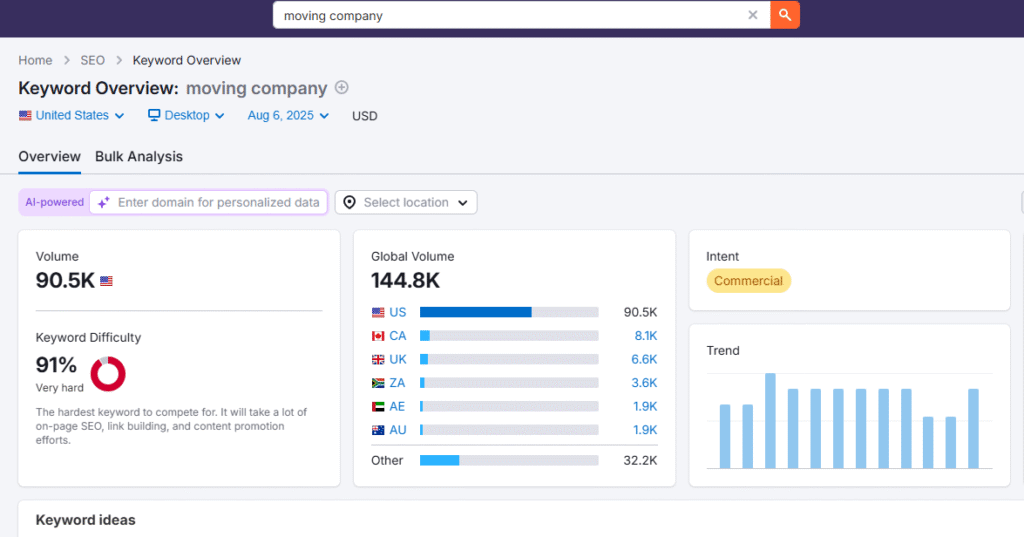
However, people searching for the broad term “moving companies” may either want to know what they do or how they work. They’re not exactly looking to hire one.
But when the search gets more specific like “moving companies in Chicago” or “moving from Chicago to NYC,” etc., it indicates high-buying intent because the searcher is actively looking for options.
If we had optimized only for the keyword “moving company,” we wouldn’t have captured the lead from this mother of four who wants to move to Florida.
That said, which type of content should you have eyes on?
Types of content with high-buying intent keywords include:
- Category keywords: These are keywords relevant to the category you are in. For example, “accounting software for startups,” “client portal for agencies,” “personal injury law firm,” or “interstate moving company.”
- Jobs to be done (JTBD) keywords: These are keywords on what people (or your target audience) want to do. For example, “how to do market research,” “how to do user acceptance testing,” or “how to manage sales leads.”
These are the kinds of keywords people are searching for to learn how to do something. And it’s great to optimize for them if you sell B2B software that’s designed to help these searchers.
For example, Hotjar, a website analytics software, published an article about “Open-ended questions vs. closed-ended questions.” In it, they explained when customer experience leaders can use either open-ended or closed-ended questions, and also showed how Hotjar can help them survey their website visitors during every transaction:

This way, they didn’t publish a JTBD article because it has high traffic volume. It’s because the searcher may need software to run this survey, and the software might just be Hotjar.
In other words, create content that gives you the opportunity to phrase how your product or brand can help the reader.
- Comparison and alternative content: These are keywords like “best x CRM software for startups,” “Zapier vs Make: which is best for automation,” or “Asana vs Trello for project management.”
You can also create this kind of content if you’re a local business. For example, Three Movers created the article “Alternatives to Two Men and a Truck” because they know people are searching for those keywords, and they rank on Google for it:
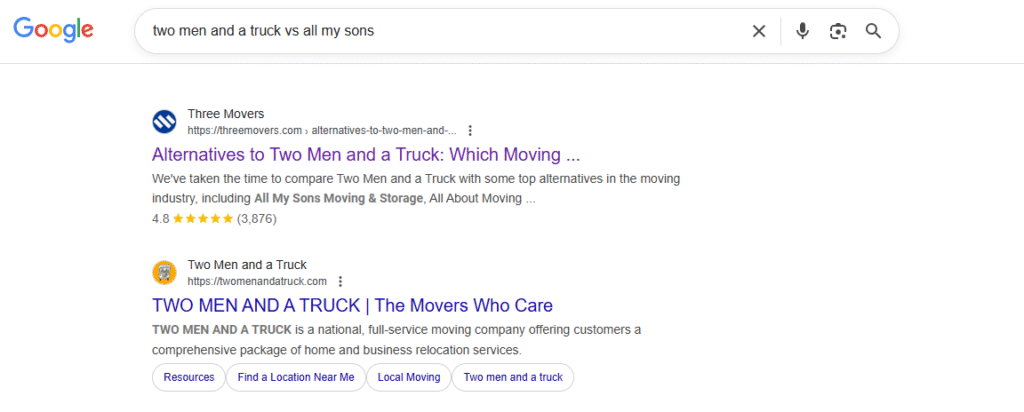
They’re also in Chat GPT when I asked for alternatives:

This shows that this strategy works. However, to ensure you’re actually mentioned in LLMs when you create this type of content, follow the second advise:
2. Associate your brand and product name with your use cases in your content.
LLMs, like humans, understand word associations. That’s because they’re designed to grasp content/language like humans. And if you phrase how your product/service works, its use cases, who it’s for, and how it can help your target market, you’ll create content that has context and helps LLMs understand your brand more.
When LLMs understand your value proposition, they can mention you in their responses.
Case in point: Hotjar and Typeform are associated with customer surveys in their blog content and overall branding, so it’s easy for Chat GPT to recommend them as the go-to software for surveys on an e-commerce site.

Same for us at HigherVisibility. We position ourself as one of the top digital agencies for franchises, such that if you ask about options, we are mentioned by Perplexity AI:

Many companies just publish articles to check off a keyword. If that’s your strategy, it’s flawed, and LLMs may never understand who your audience are and how your brand helps them.
Takeaway: mention your brand name in your articles and how you help your target audience.
However, to effectively do this, you can’t target every keyword. You can instead decide on which topic or keyword to pursue based on two things:
- Whether it reflects true customer pain points.
- Whether your product is relevant and can help the readers. Ahrefs categorized this in 3 ways:
- 3 – my product is an irreplaceable solution.
- 2 – my product helps, but it’s not essential.
- 1 – my product can be mentioned in passing.
- 0 – no way to mention my product.

You can score the topic or keyword idea a three if you can explain how your product (or brand) can help the reader while reading the article you want to write. This can lead to an easy sale (since the reader may definitely want to learn about your product).
For context, Hotjar wanted to target the keyword website bugs, and they wrote about it only after they realized that they can mention how their software can help readers find and fix bugs.
In their article, they tell readers what to do and how to use Hotjar to do it:

If any user needs a way to fix website bugs and head to LLMs, they will mention how Hotjar can help because Hotjar has positioned and associated its content with this use case.
Note: Hotjar’s topic for the article is “How to find (and fix) website bugs fast: your ultimate strategy.” This is a JTBD content that also has high-buying intent: The reader wants to resolve website bugs, so even if they weren’t thinking about using Hotjar to do it, now they have a reason to. And since Hotjar’s article is helpful, it will stay top of mind when they want to make the buying decision.
Back to how to prioritize content ideas according to Ahrefs, you can also write content if your topic idea scores 2 (my product helps, but it’s not essential). This helps you show how your product can help.
This way, when someone prompts an LLM and it scans the web, it has detailed context about your ICP, their challenges, tools they’ve tried but didn’t like, and why yours is better for their use cases. And if your software is better than the alternative, you’ll be mentioned and can potentially be chosen by the reader.
However, if your topic idea ranks 1 (my product can be mentioned in passing) or zero (no way to mention my product), don’t write on it.
This way, you’ll be able to provide specific, differentiated content on how your product helps users and also help fulfill their search intent.
3. Optimize your content with traditional keywords.
Traditional SEO still works. In fact, according to a study, content that ranks top three is cited in Chat GPT compared to content that ranks lower:

In an Ahrefs study, the higher you rank on Google search, the better your chances of being mentioned in AI Overviews:
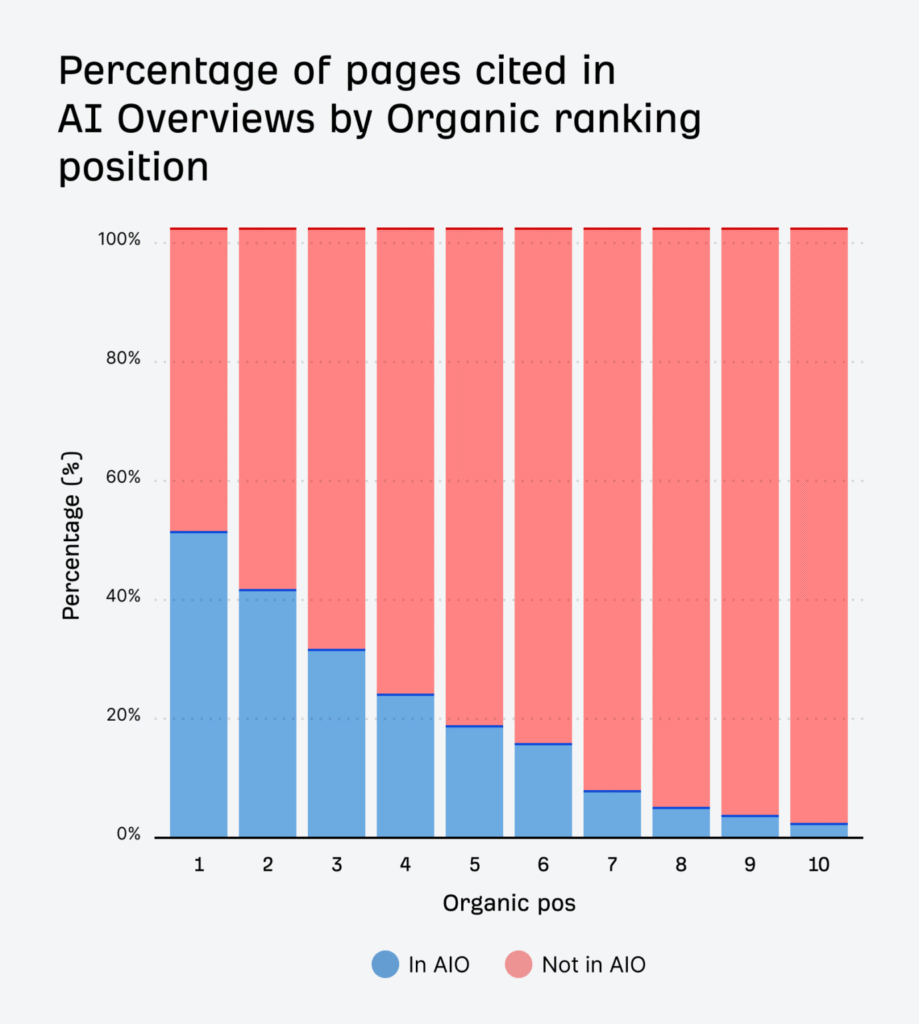
This doesn’t mean that if you’re not ranking in the top three of organic search, LLMs won’t cite you. No.
It only means that you have more chances of being mentioned in LLMs when you infuse relevant keywords in your content.
After all, Open AI, Perplexity AI and other search engines have said that they generate data from third-party sources, which includes Google and Bing search.
For example, in a study by Tomasz Rudzki, he showed that Google is still relevant in how AI search results synthesize your keyword. Here’s a screenshot from Perplexity AI for the query “what is SEO? Compare it to PPC.”
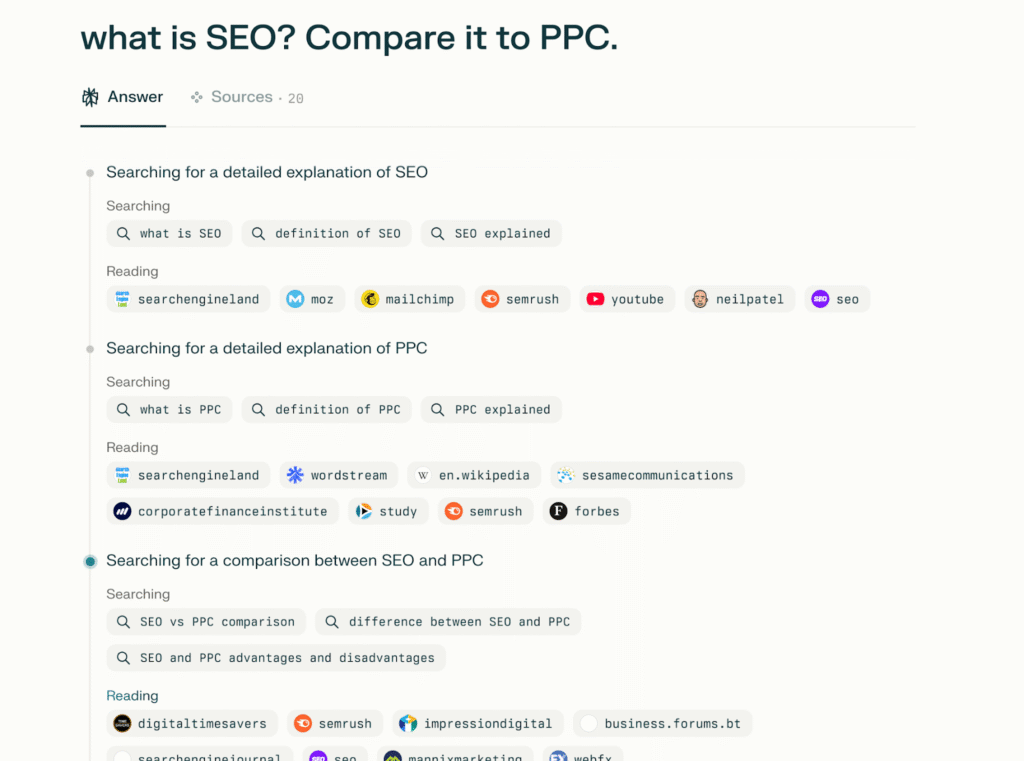
Perplexity AI broke down the query into multiple queries and used organic search engines to find the answers that are most relevant to the original query. This breakdown, by the way, is what is referred to as query fan-out, how LLMs “expand a single user query into multiple sub-queries to capture different possible user intents, retrieving more diverse, broader results from different sources.”
If these pages weren’t optimized for traditional search, Perplexity AI won’t be able to parse or cite them as sources while providing an answer to the query.
And as we can see below, AI Overviews, Chat GPT, and Perplexity AI are seen to pull their sources (mentions) from the top 10 results from the organic search.
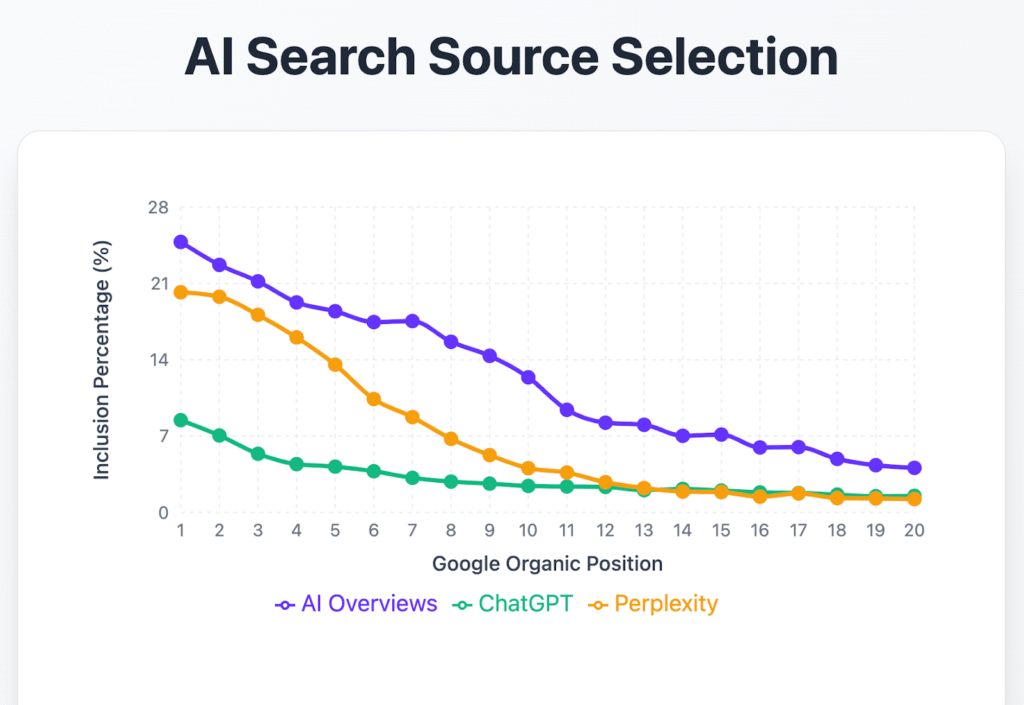
All these mean that traditional SEO isn’t dead, and you can still target traditional keywords to optimize your content.
One takeaway: make sure to phrase how your product helps the users and the use cases it helps with.
4. Use plain-language explanations early in the content.
I’ve explained that LLMs, like humans, understand language and can synthesize information easily. It’s why they dissect your query into sub-queries to capture the most relevant intent behind your search.
So when you’re optimizing your content, be intentional about your choice of words.
- Is it easy to grasp?
- Are there relevant, semantically related keywords to the topic you’re covering that can help an AI search engine understand your content even more? Use them.
- Are the terms I’m using too technical for this target audience to understand? Simplify it.
- Are there unnecessary cliches or inside jokes that will be hard to explain? Take them out.
When you answer these questions, you’ll be able to choose what to write to make your content accessible to humans and search engines. And this extends to how you structure your blog content.
Think about how someone might phrase a follow-up question after reading an AI summary. If your content answers that second layer of intent, your content is helpful, and readers might want to stay on your website when they’re referred from AI search engines. This leads to the next point:
5. Publish content that’s easy to scan.
One of the easiest ways to improve visibility in LLM’s is to make your content scannable. That means using logical headers (H1s to H4s) that show how each subsection fits into the whole piece. This helps you clarify your structure and make the content easier to parse.
It’s also important to go straight to the answer after each header. It’s called bottom line up front (BLUF). Don’t bury the main point under a long introduction. Instead, write the answer first, then explain.
For context, some SEOs believe using Q&A-style headers can improve visibility in LLMs and are using it. This means they write their H2s and H3s with wordings like:
- “What’s the best alternative to Podio for client portals?”
- “Why is Florida getting so popular?”
In this article, you’ll see that they immediately wrote why Florida was getting popular,
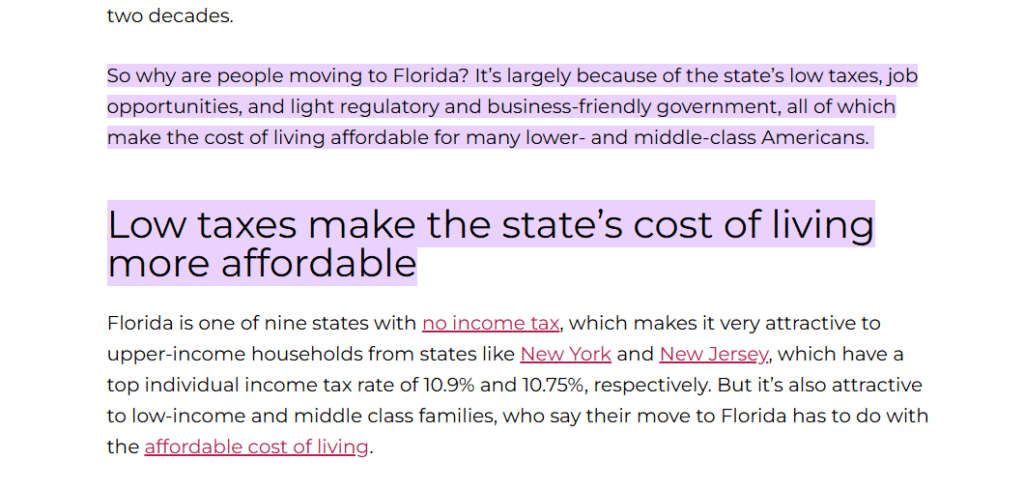
which is why they ranked on AI Overviews.
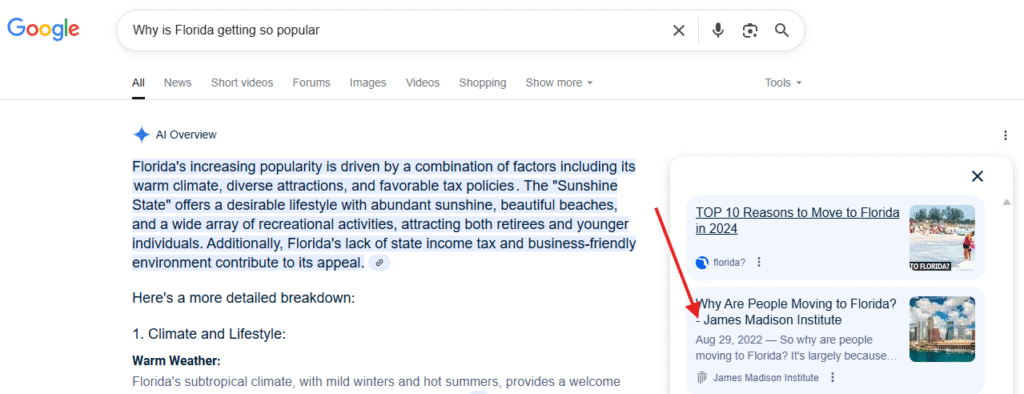
The point is that when you use Q&A queries type of headers, answer the question first, then explain later. Here’s another example:

Even if you have a regular heading, use the BLUF approach.
The idea is to show value upfront so people can read your content. You can also do these to make your content more scannable:
- Keep paragraphs short (2 – 4 lines is often enough).
- Use bullet points for lists or steps.
- Highlight key points in bold where it makes sense.
- Include quick takeaways or summaries under long sections.
When possible, structure each paragraph as a self-contained point that can stand alone as an answer. You can also use tables for comparisons; they make it easier for humans and LLMs to scan, compare, and extract information.
6. Internal linking still matters.
Internal links are still one of the most effective ways to show the relationship between different content pieces on your site. They help traditional search engines understand which pages are important, how topics are grouped, and which content supports what. But they also play a role in how generative engines interpret your site.
When LLMs crawl your site, they follow internal links to piece together related topics and surface answers that match specific use cases. So if you’re trying to get mentioned on AI chatbots, linking your commercial pages with high-intent blog posts or helpful guides can reinforce the themes you want to be known for.
This is especially useful if you’re building topical authority or are following a topic cluster approach to content marketing.

For example, if you sell CRM software and your article on “how to generate leads” links to articles on “how to manage customer pipelines” or “how to automate follow-ups,” it tells the reader and LLMs that your brand has depth on the subject. So the LLM can give more details on how you can help the user much better because of all these extra nuances.
It also helps with context. If the page the LLMs is skimming doesn’t include certain keywords or phrasing, but a linked blog content does, LLMs can pull from both pages when surfacing your brand. This increases your chances of being cited in multi-intent prompts.
A few things to keep in mind when linking internally:
- Link related articles with descriptive anchor text that reflects the topic, not generic phrases like “click here.”
- Make sure your product or service pages are linked from relevant supporting content.
- Use internal links to guide the user through a journey (so they’re educated, and there’s a clear path from there to where they can sign up). Here’s an example of good internal linking from marker.io:

You can see that they linked to other resources after the article on marker.io alternatives, so readers can learn more about their product and also read how their product can help companies save over 100k annually.
If you structure your internal linking well, you’ll not give AI engines more context to recognize when your brand is the right recommendation for a user prompt. And when that happens, you have high chances of generating high-quality leads from AI chatbots.
Wrapping Up:
Generative search engines are still evolving, and buyer behavior is fragmented across tools. However, the more consistently you connect your brand with the right problem, solutions, and use cases, the more often you’ll be surfaced. And the more measurable that visibility will be.
At HigherVisibility, we help clients analyze brand mentions and referral traffic from LLM platforms. We help them see where they show up, why they’re being cited, and how to strengthen that presence.
The tactics in this article reflect what has worked so far, and we’re applying them every day to help our clients show up more in generative and traditional search engines.
